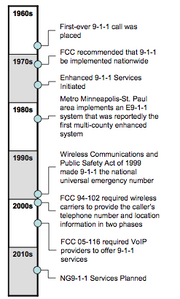Overview[]

The 9-1-1 system architecture, built in the 1970s, was based on a decades-old, circuit-switched network technology. Early 9-1-1 call processing was basic, using three-digit dialing and circuit-based transmission to PSAPs, and neither Automatic Number Identification (ANI) nor Automatic Location Identification (ALI) functions were available. The calls were received and processed through the public switched telephone network (PSTN) infrastructure to the PSAP. As new technologies were introduced, modifications were made to establish connections to this basic 9-1-1 infrastructure. Enhanced 9-1-1 (E9-1-1) enabled the functionality to route calls to appropriate PSAPs based on the location of the caller using selective routing equipment, as well as provide PSAPs with the number (ANI) and address information associated (ALI) with the caller.
In the mid-1990s, with the proliferation of wireless technologies, the 9-1-1 system faced new challenges — receiving 9-1-1 calls from cell phones and identifying the location of the caller. The Federal Communications Commission’s (FCC) Order 96-26415 established requirements and deadlines in two phases, requiring that all wireless carriers provide the caller’s telephone number and location information to the PSAPs. In 2005, with the growth of Voice over Internet Protocol (VoIP) telephony, the FCC issued Order 05-11616 requiring interconnected VoIP providers to offer 9-1-1 services to all subscribers. VoIP is technology supporting voice communications over IP networks such as the Internet or other packet-switched networks. Most commercial VoIP services provide an interface to the PSTN allowing calls to traditional telephones. Wireless and VoIP technologies required additional, individual modifications to the previous 9-1-1 infrastructure — within thousands of 9-1-1 networks across the country — to enable 9-1-1 calls to connect to PSAPs.
The growing consumer market penetration of both wireless and VoIP telephony, and the increasing use of advanced technologies they represent, has underscored the limitations of the current 9-1-1 infrastructure and funding mechanisms. The U.S.'s 9-1-1 system, based on decades-old technology, cannot process video, text, images and other data that are increasingly common in personal communications. The pace of change in technology will not slow. To ensure that the general public has access to 9-1-1 from new and emerging devices that have multiple ways of communicating, the 9-1-1 infrastructure needs to be upgraded to accommodate new technologies. If left unchanged, the current 9-1-1 system will face a multitude of pressures as society and technology continue to advance.